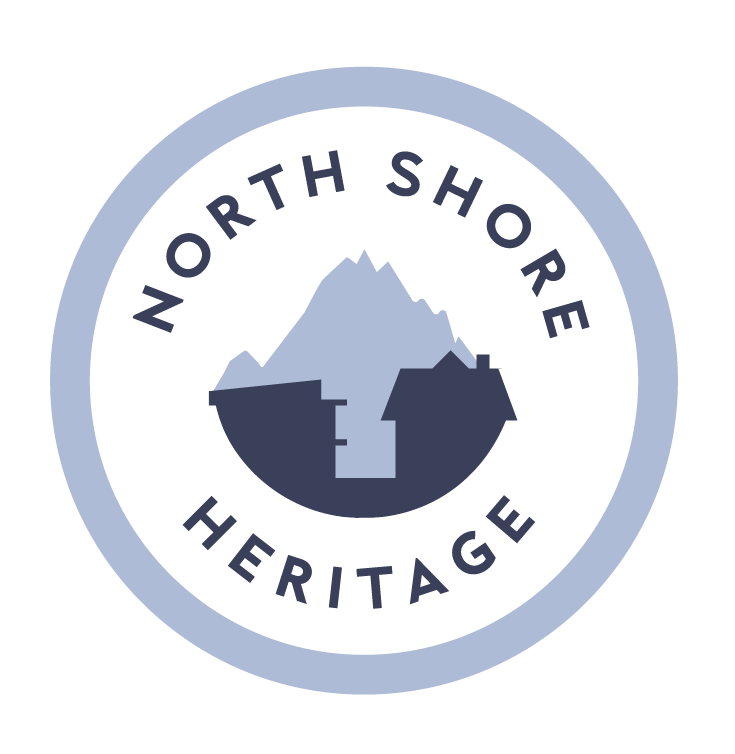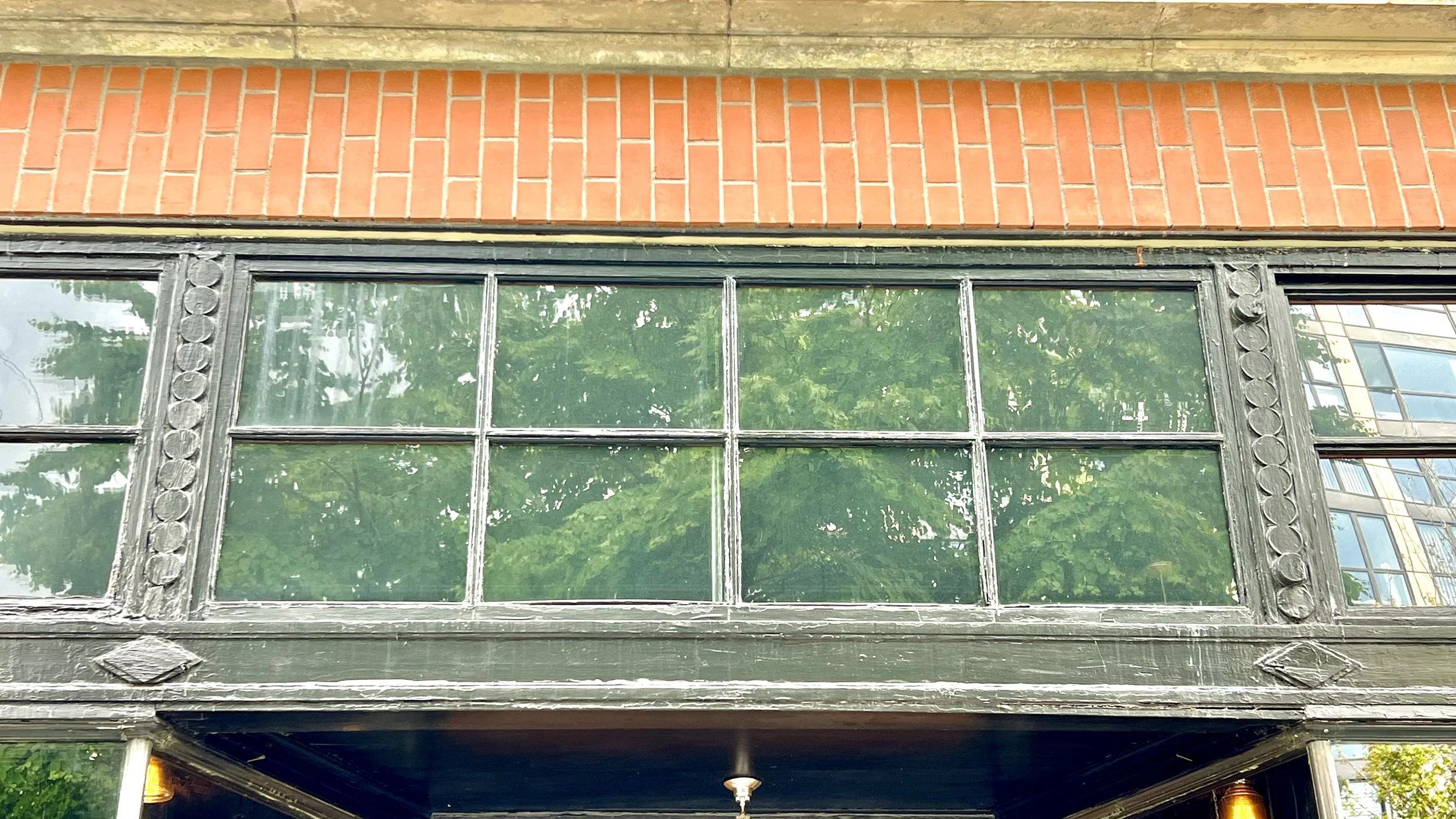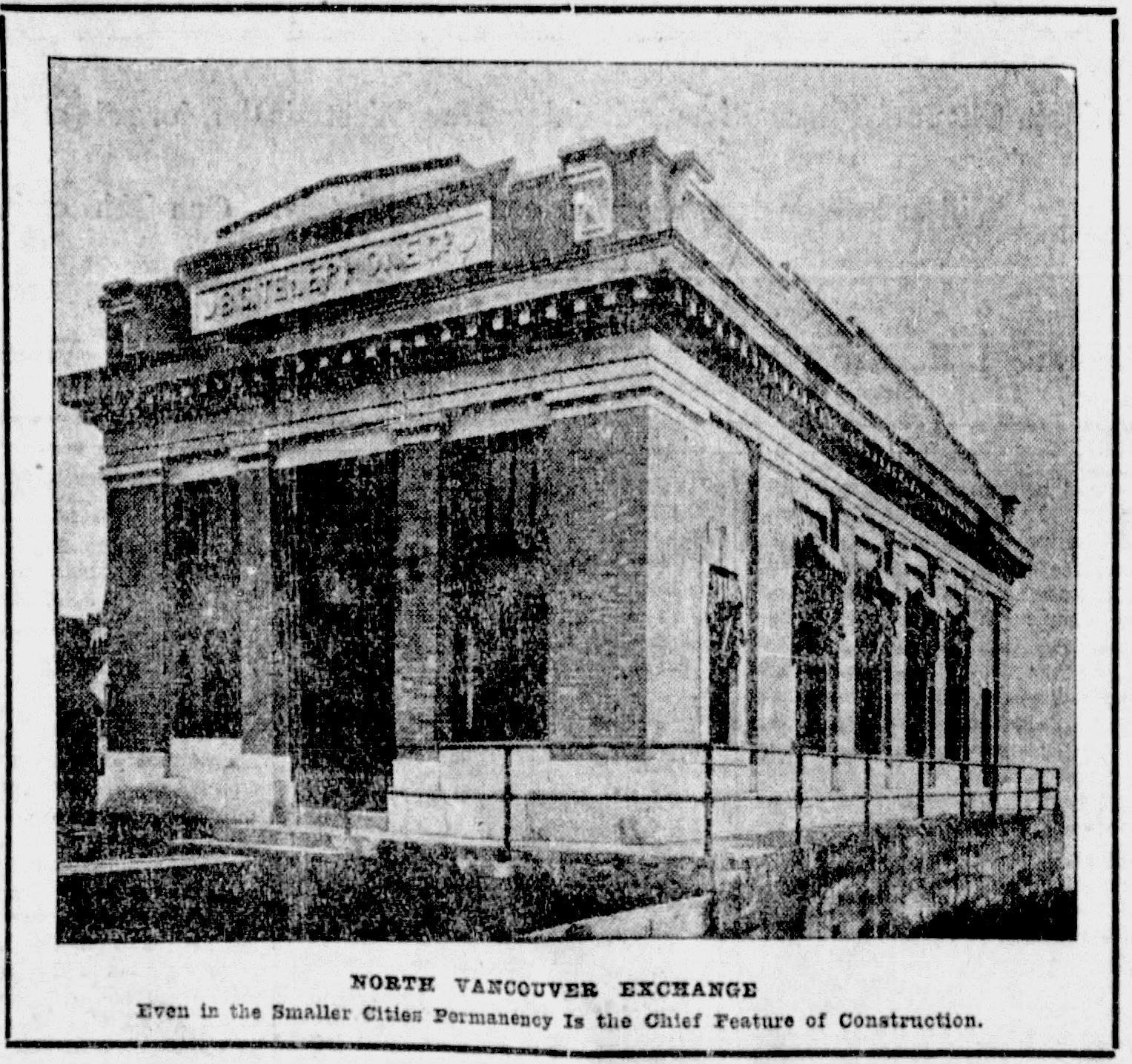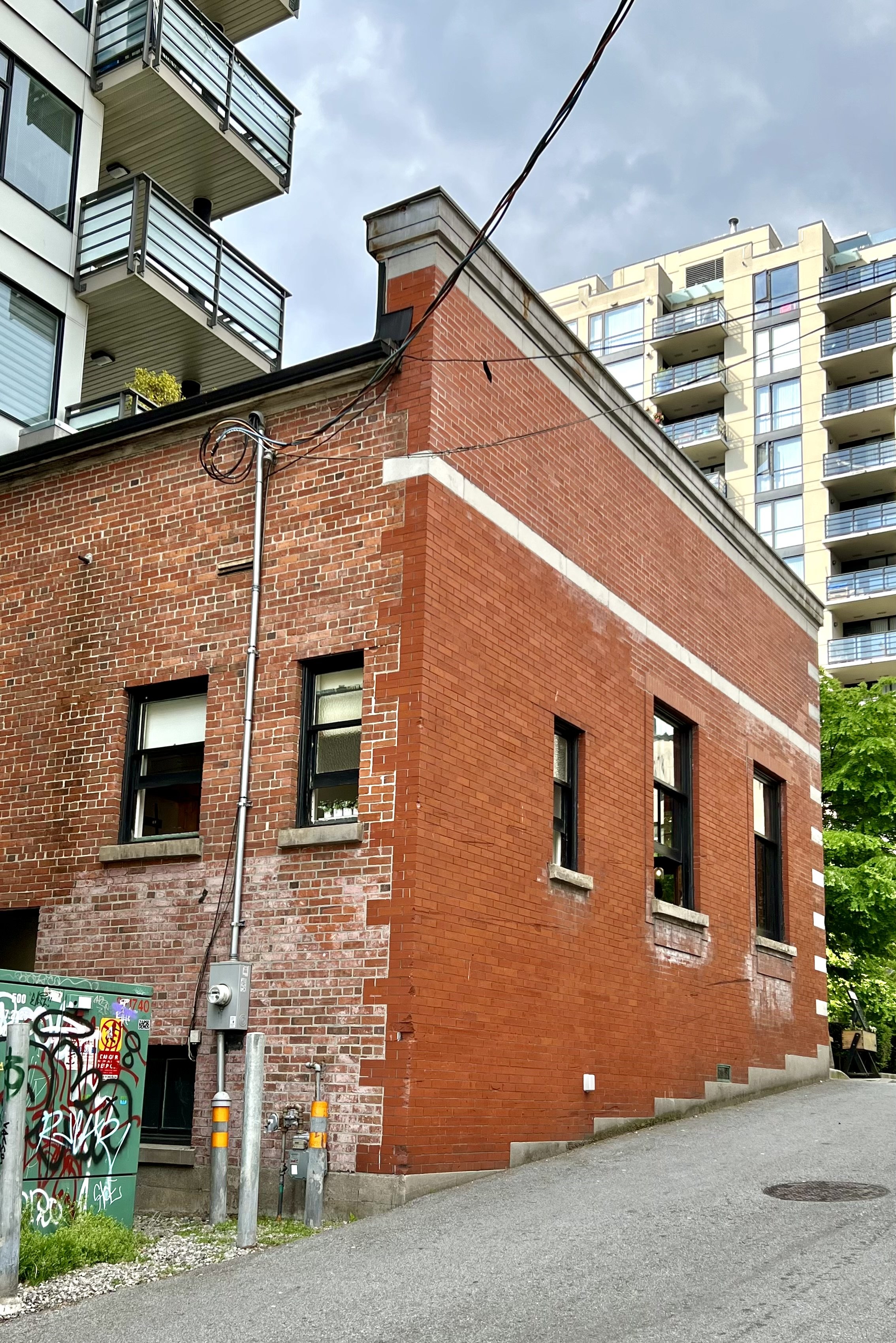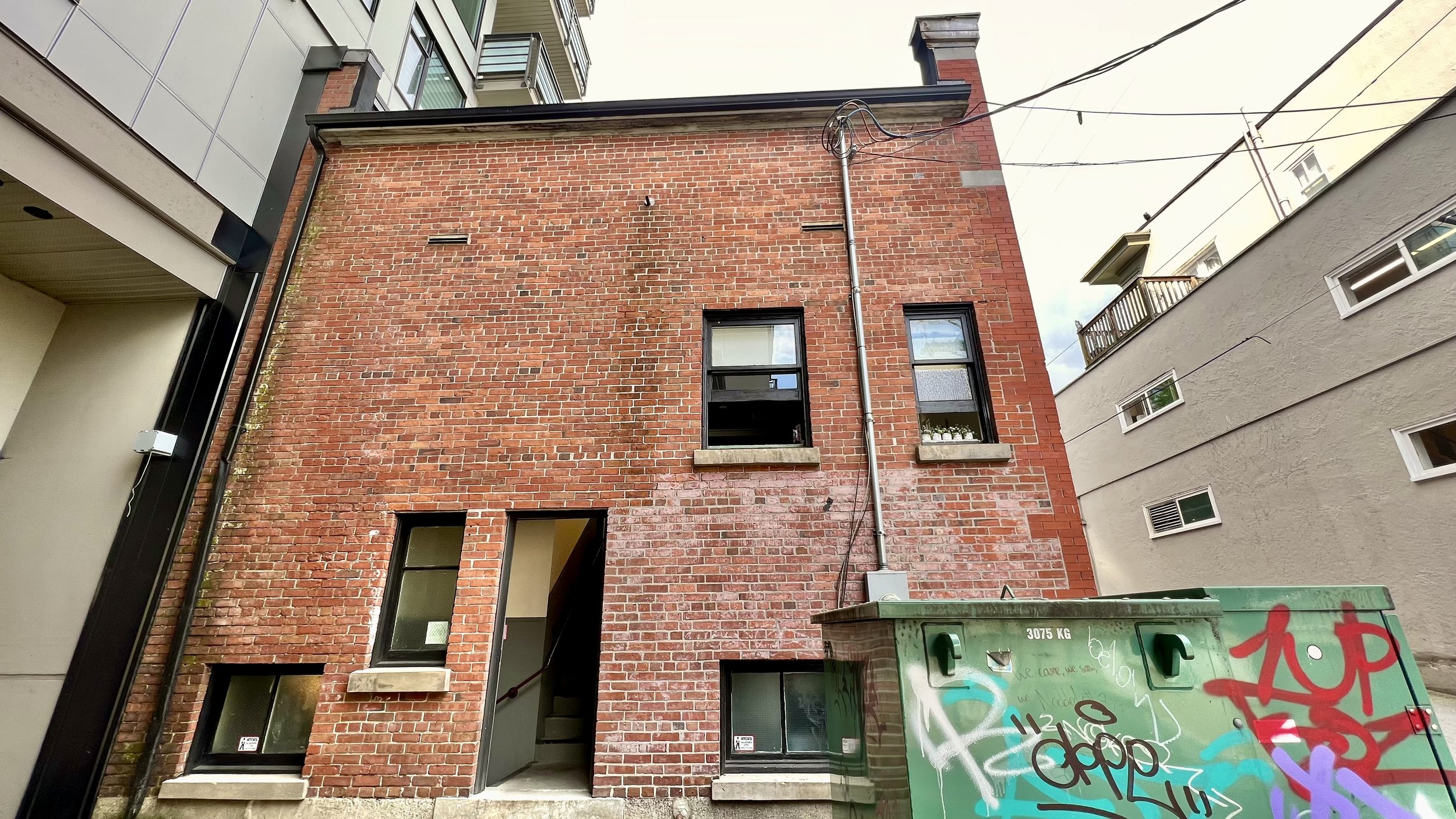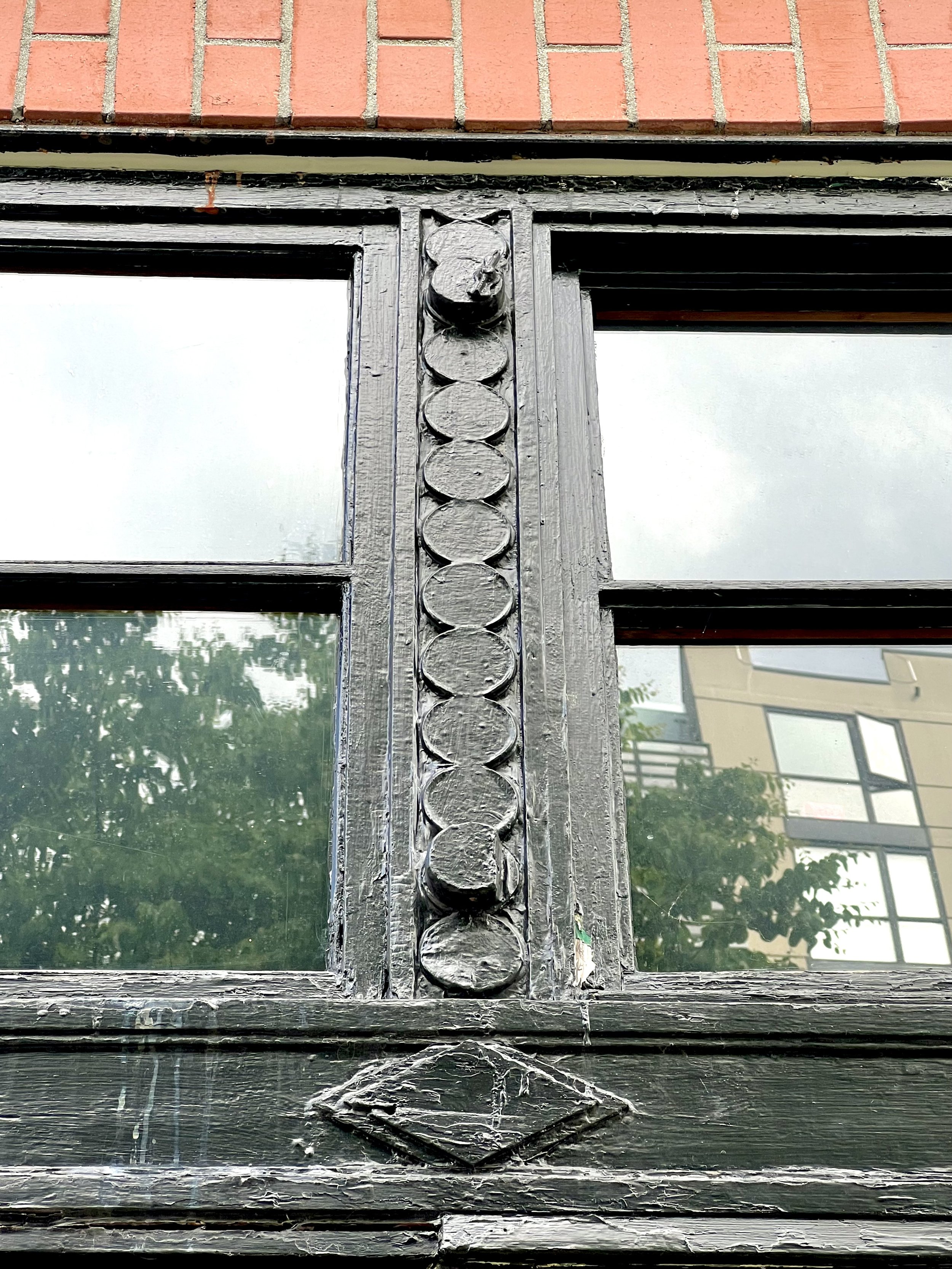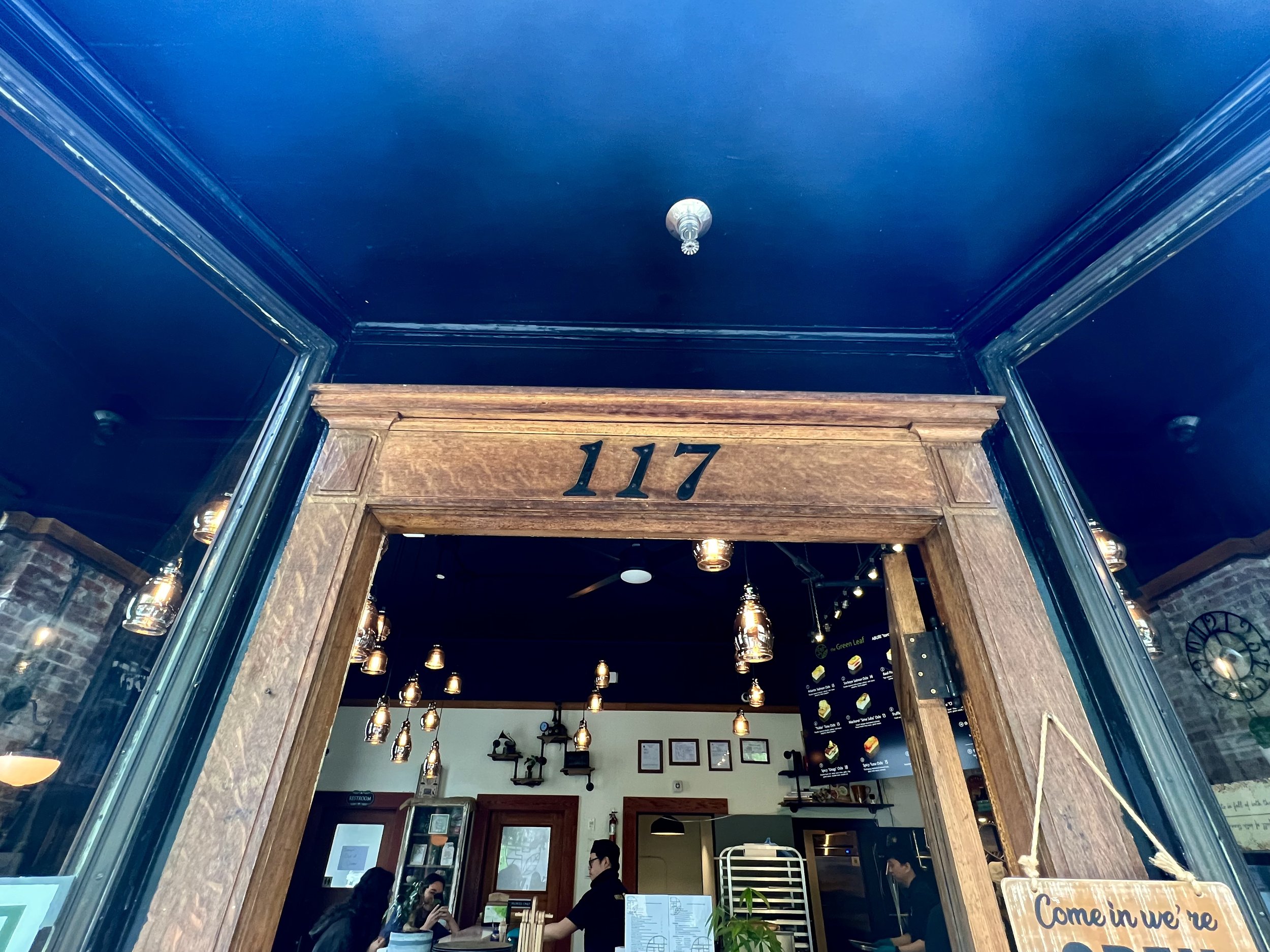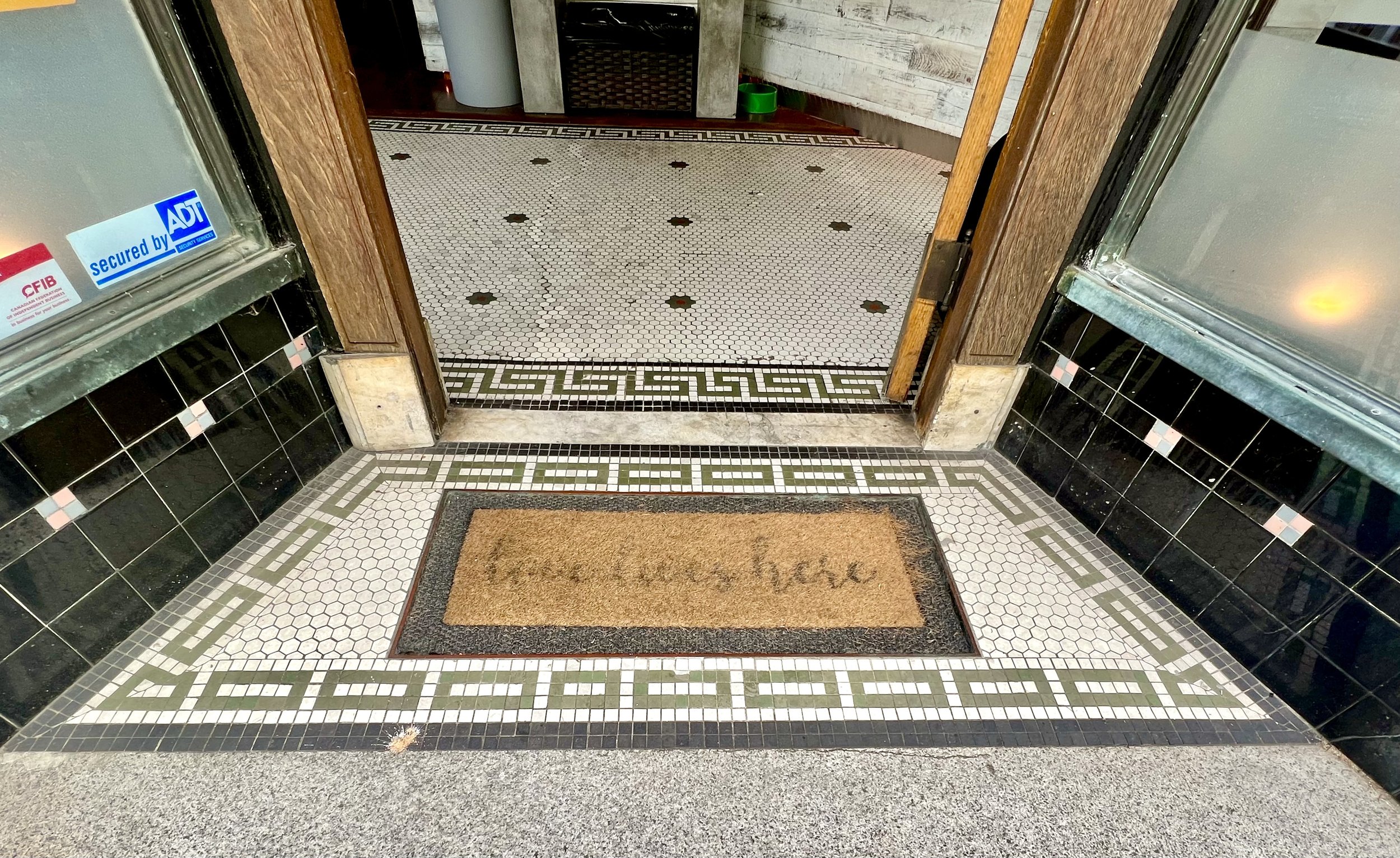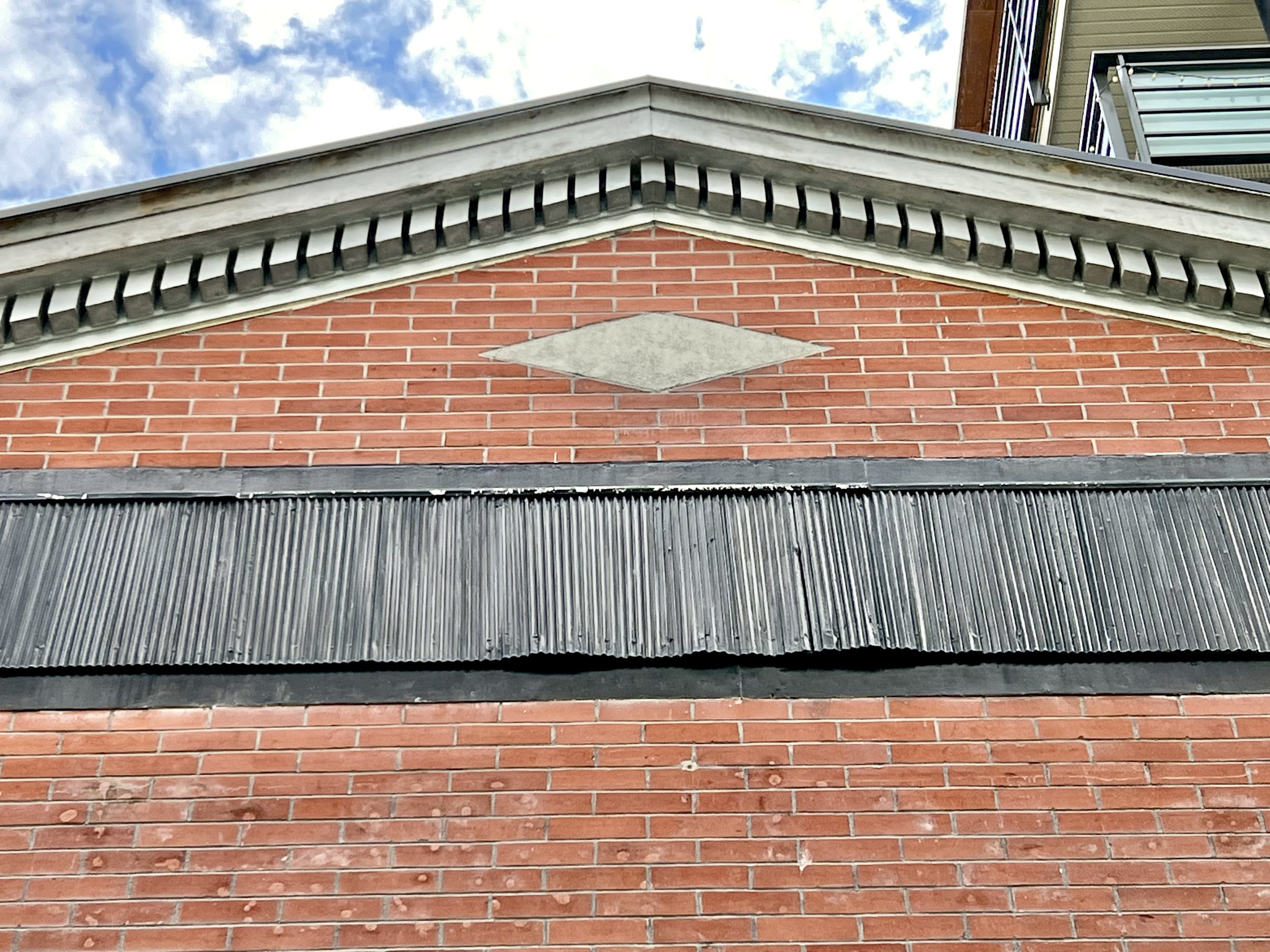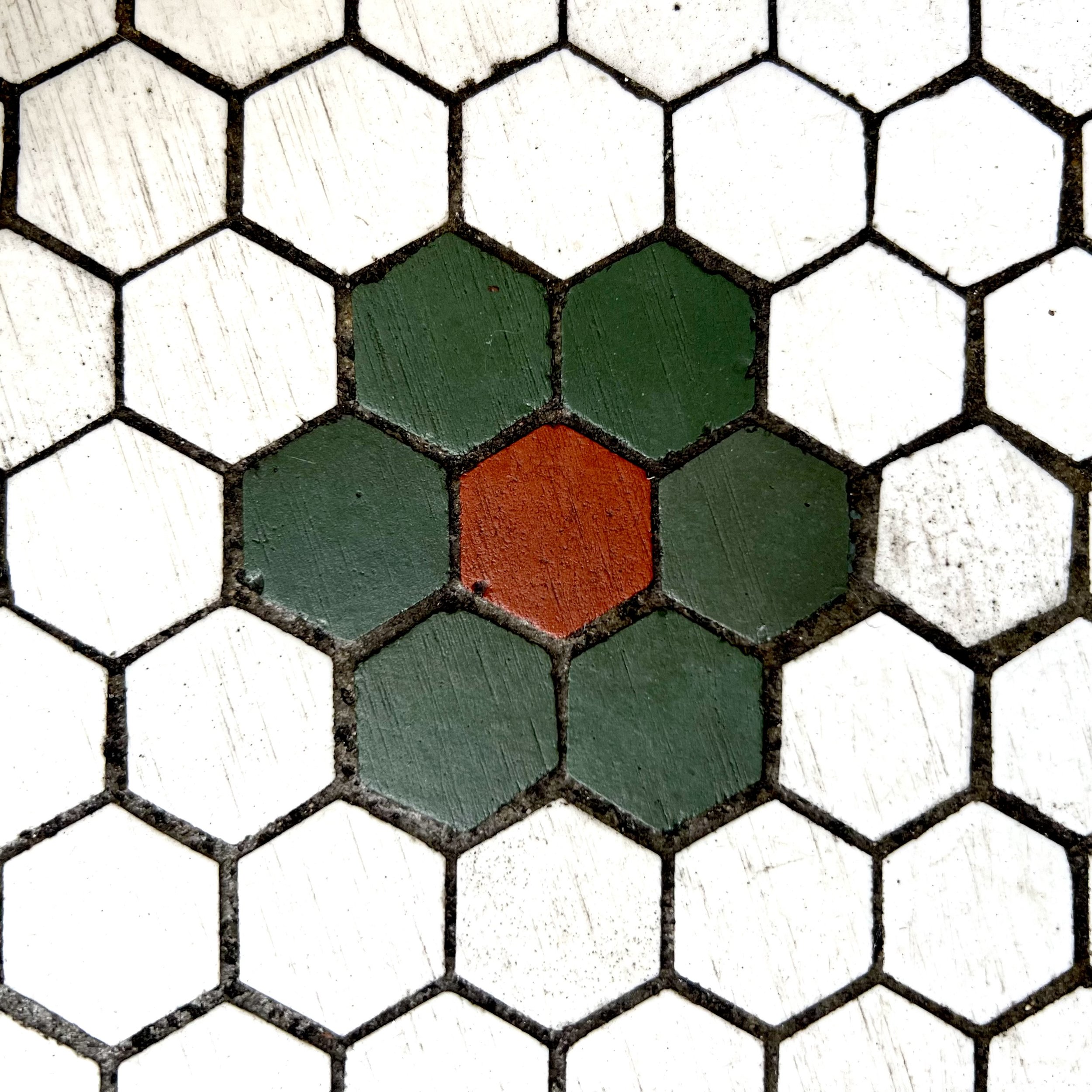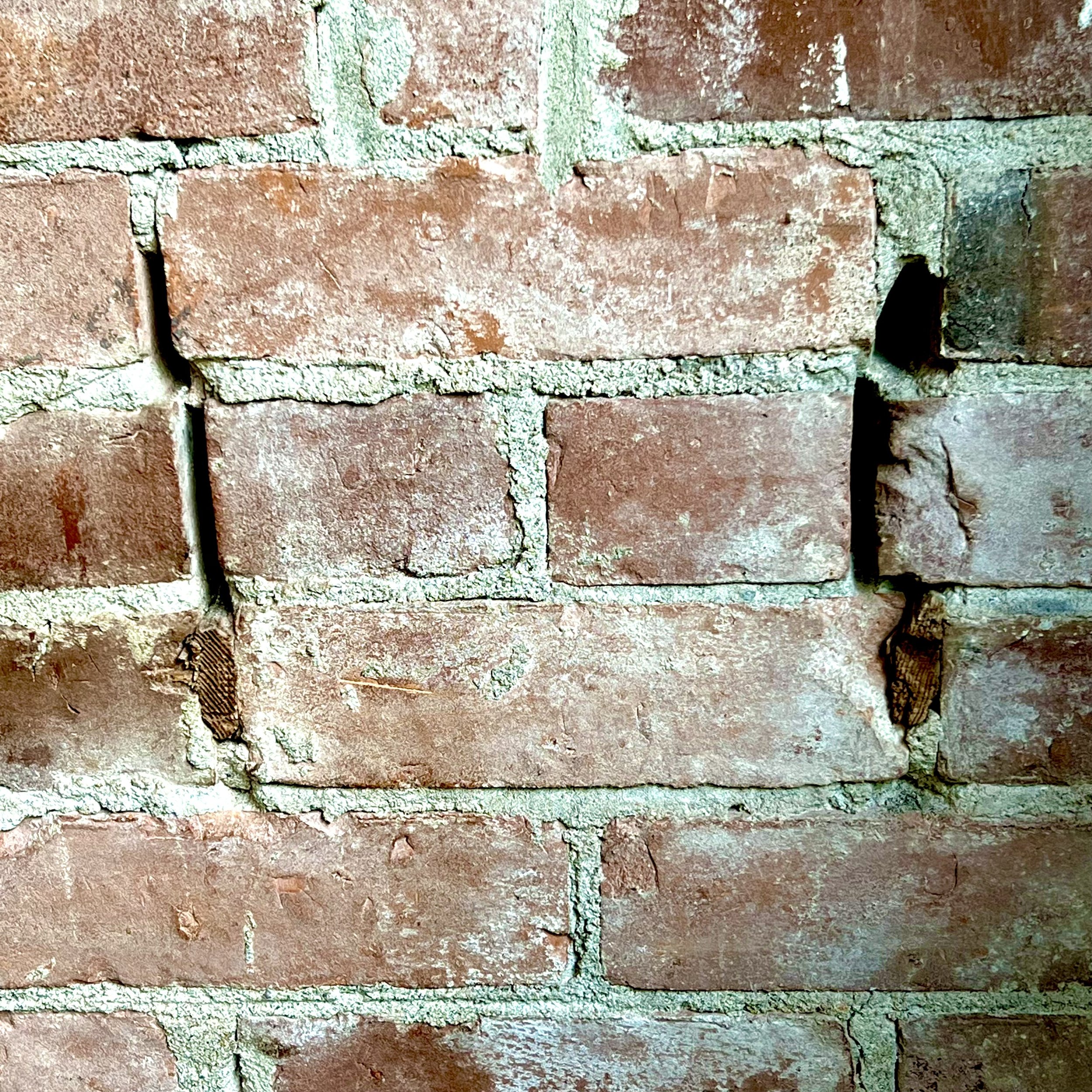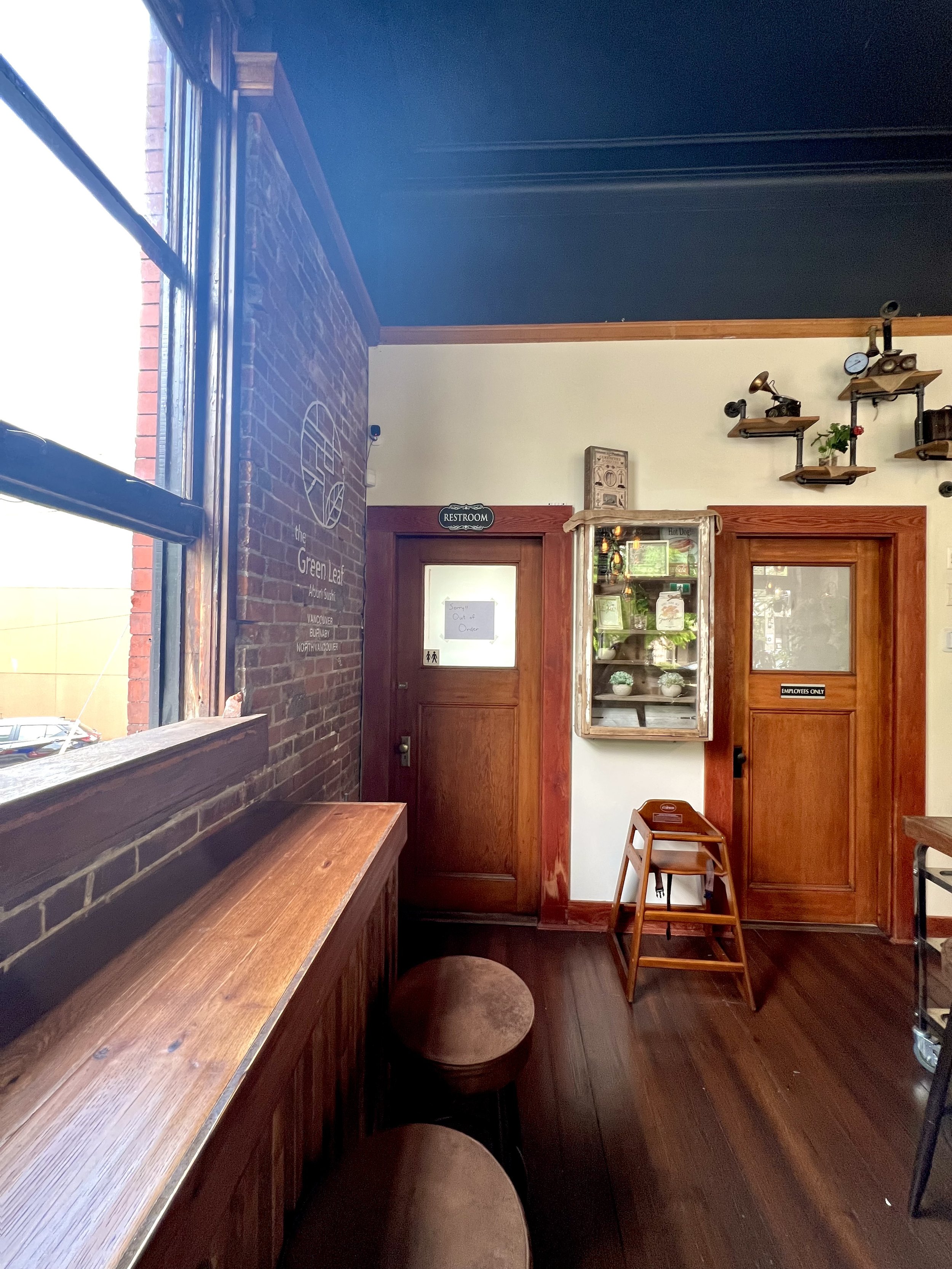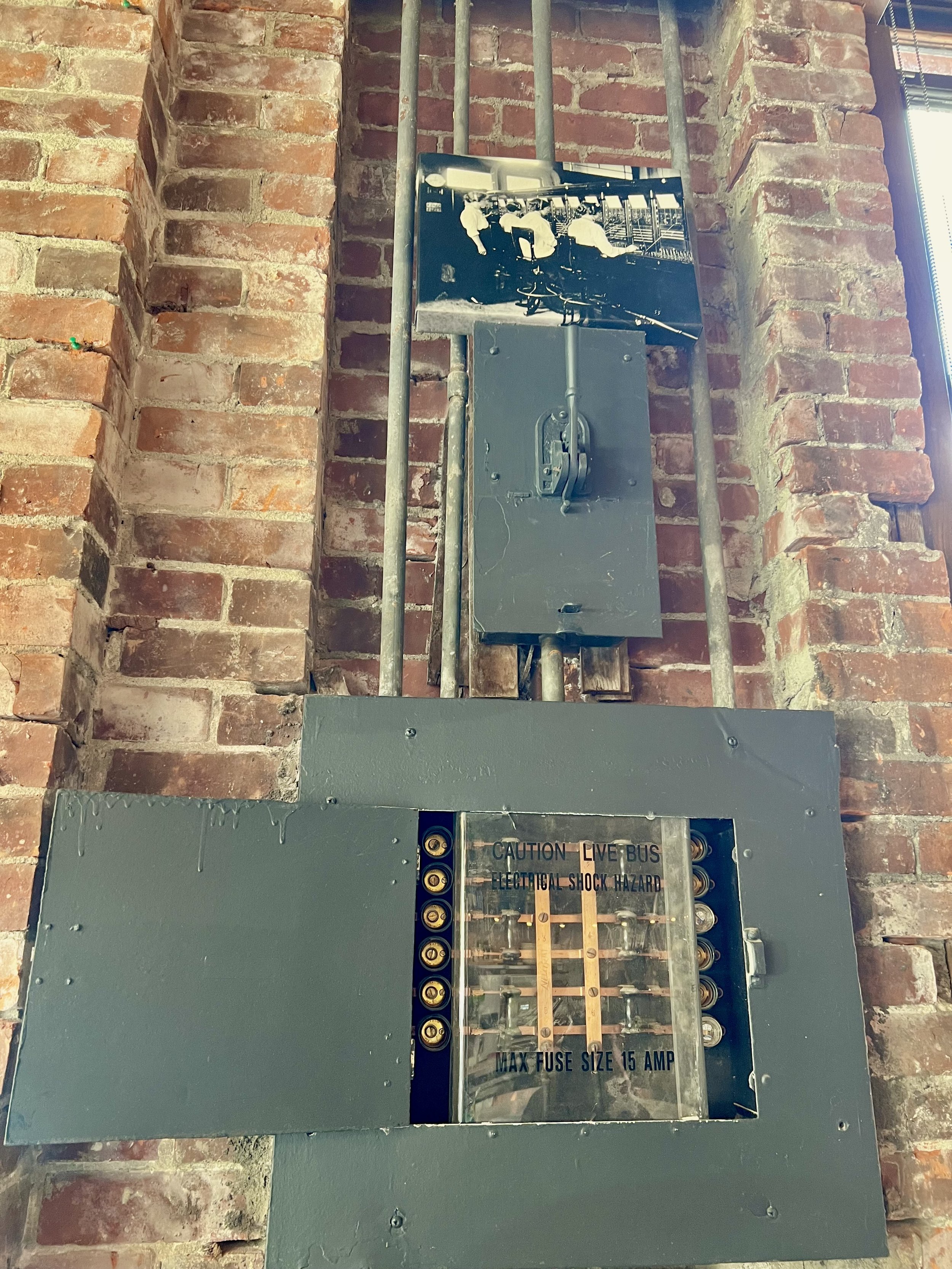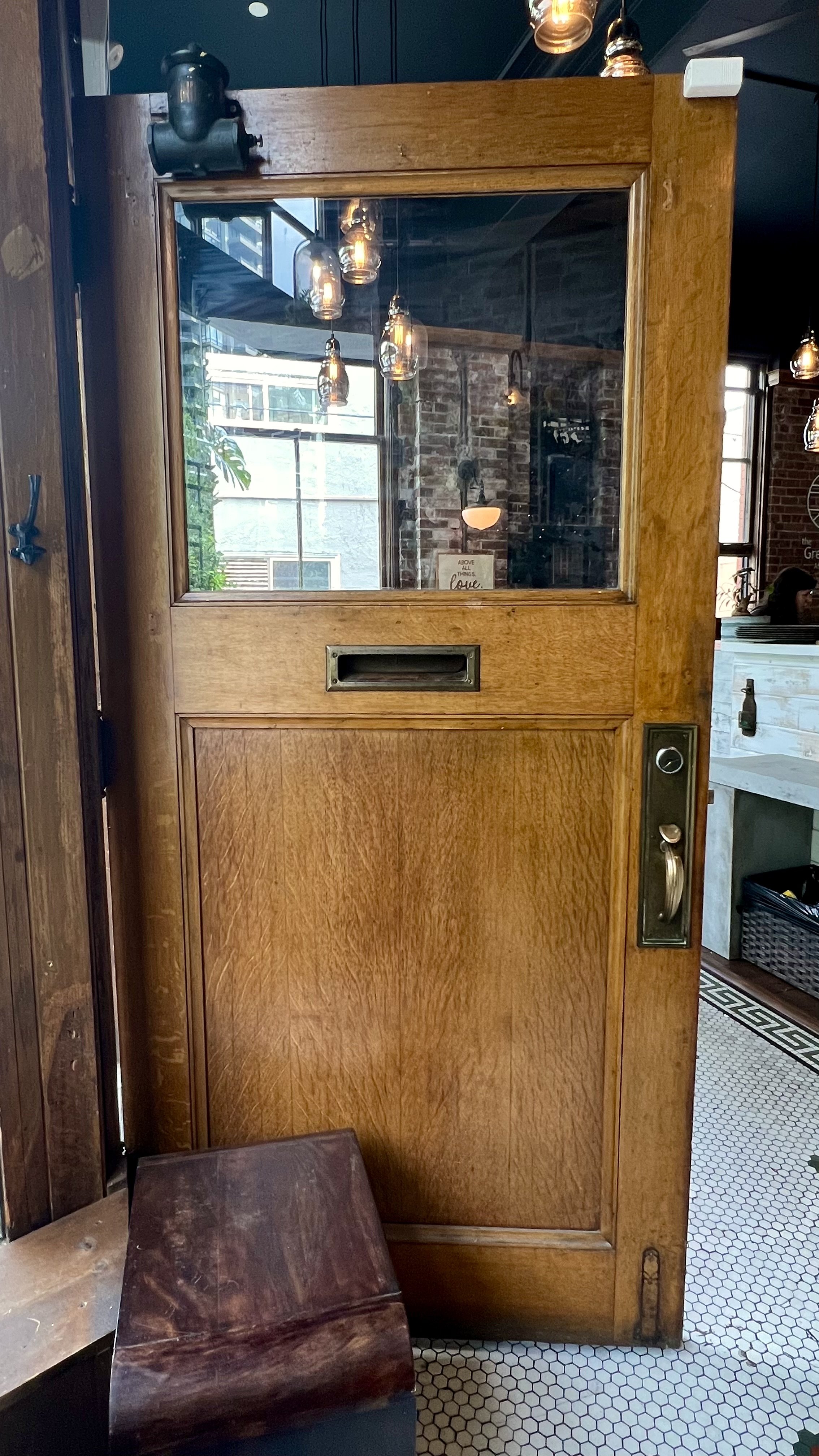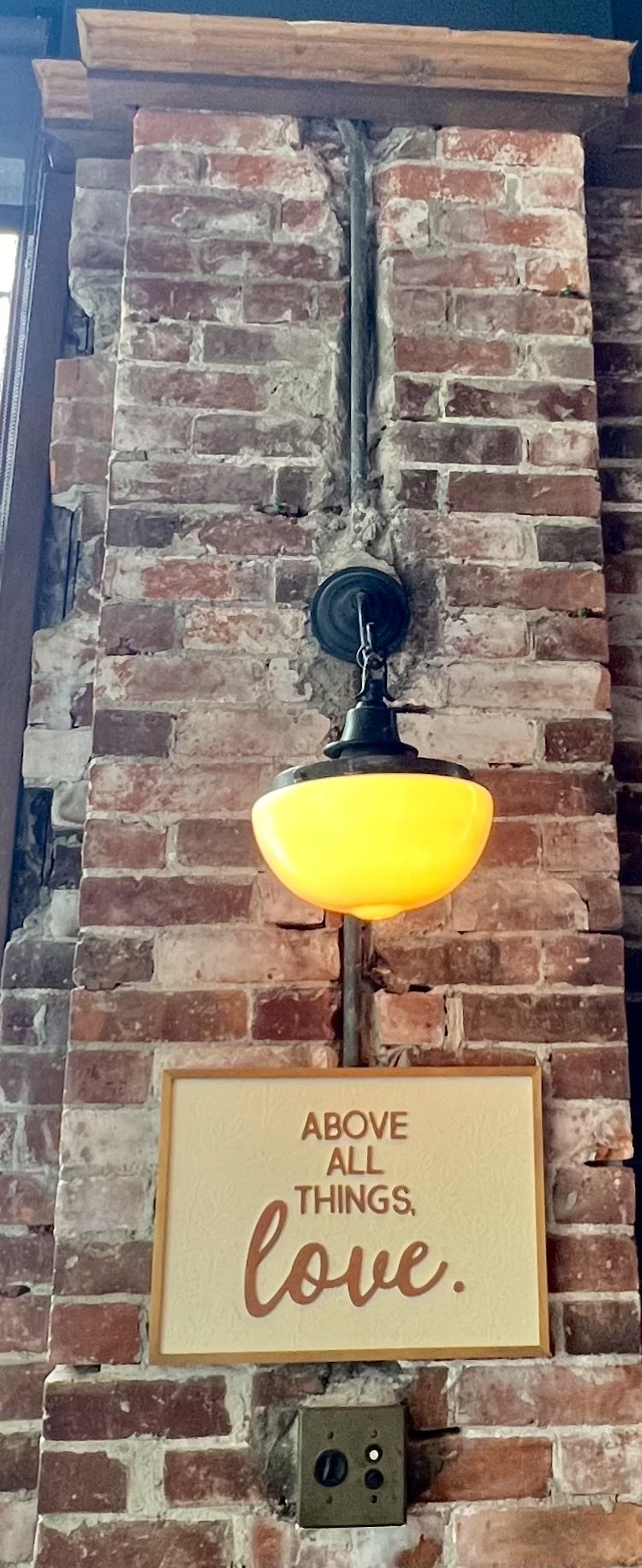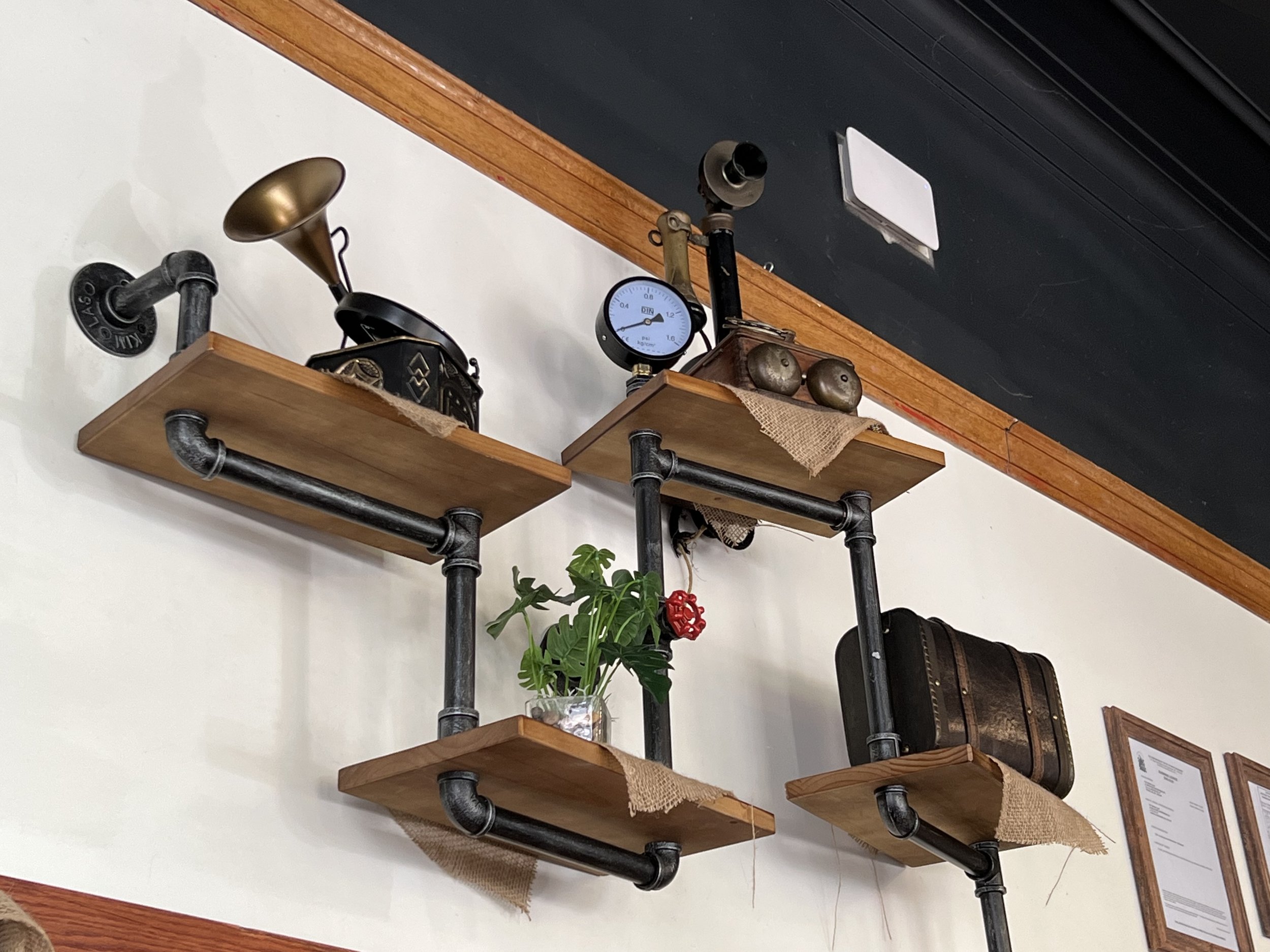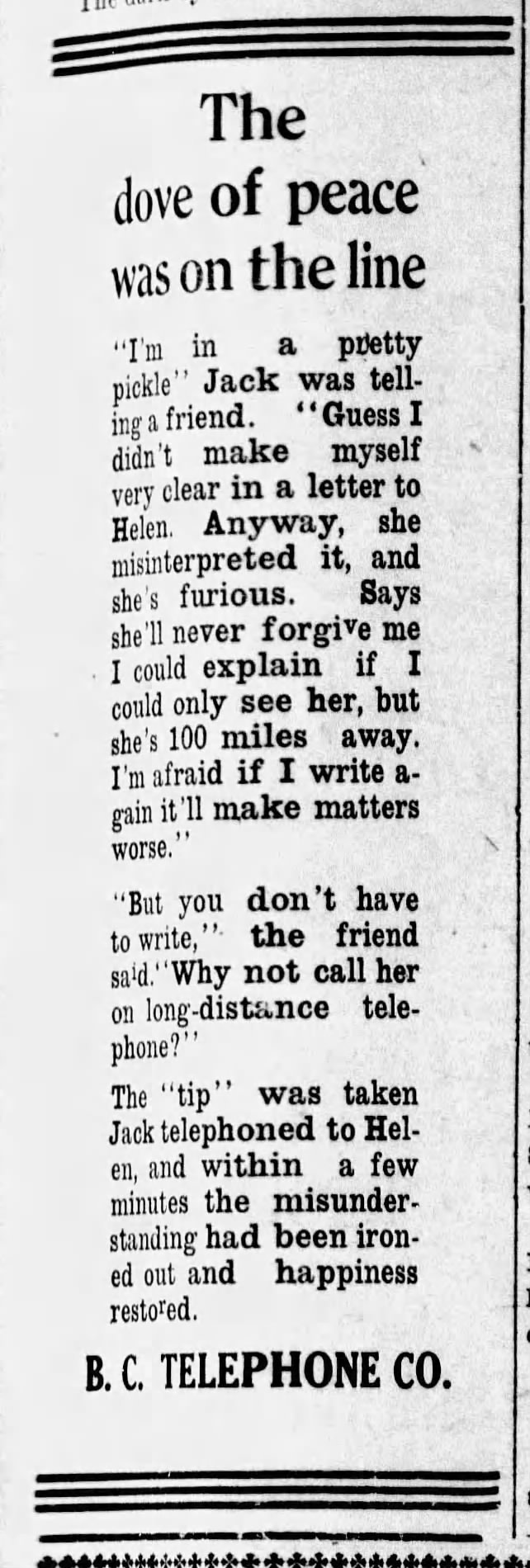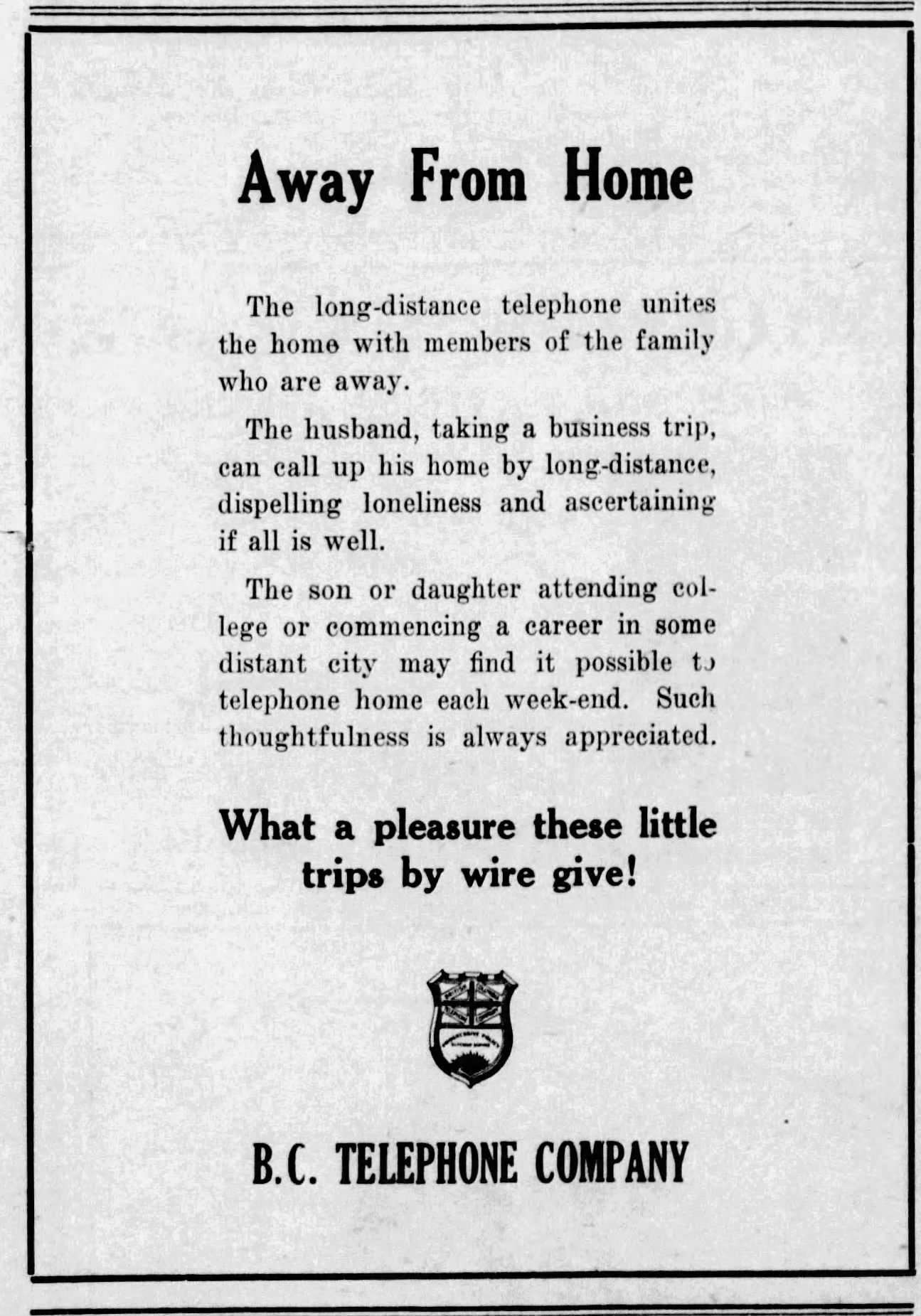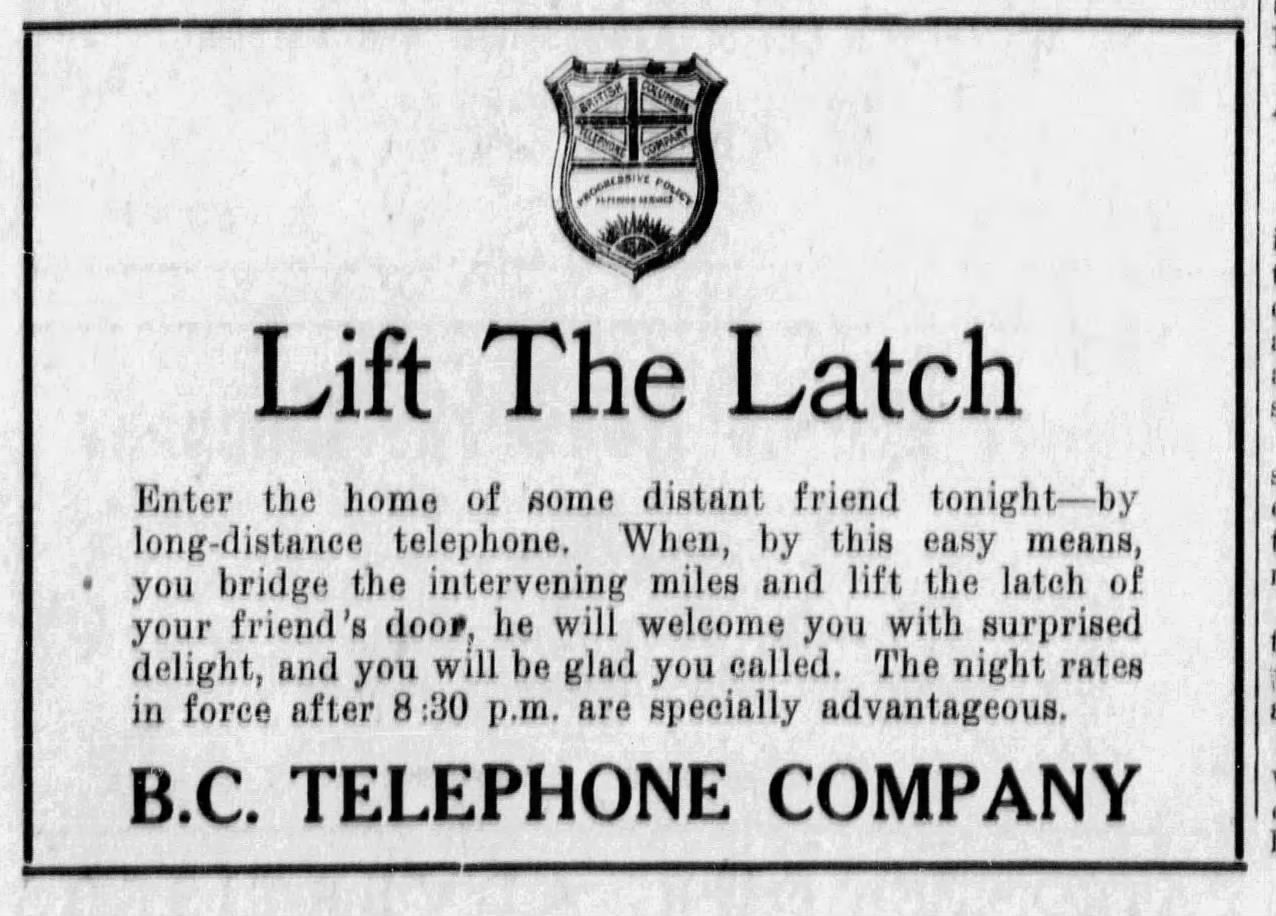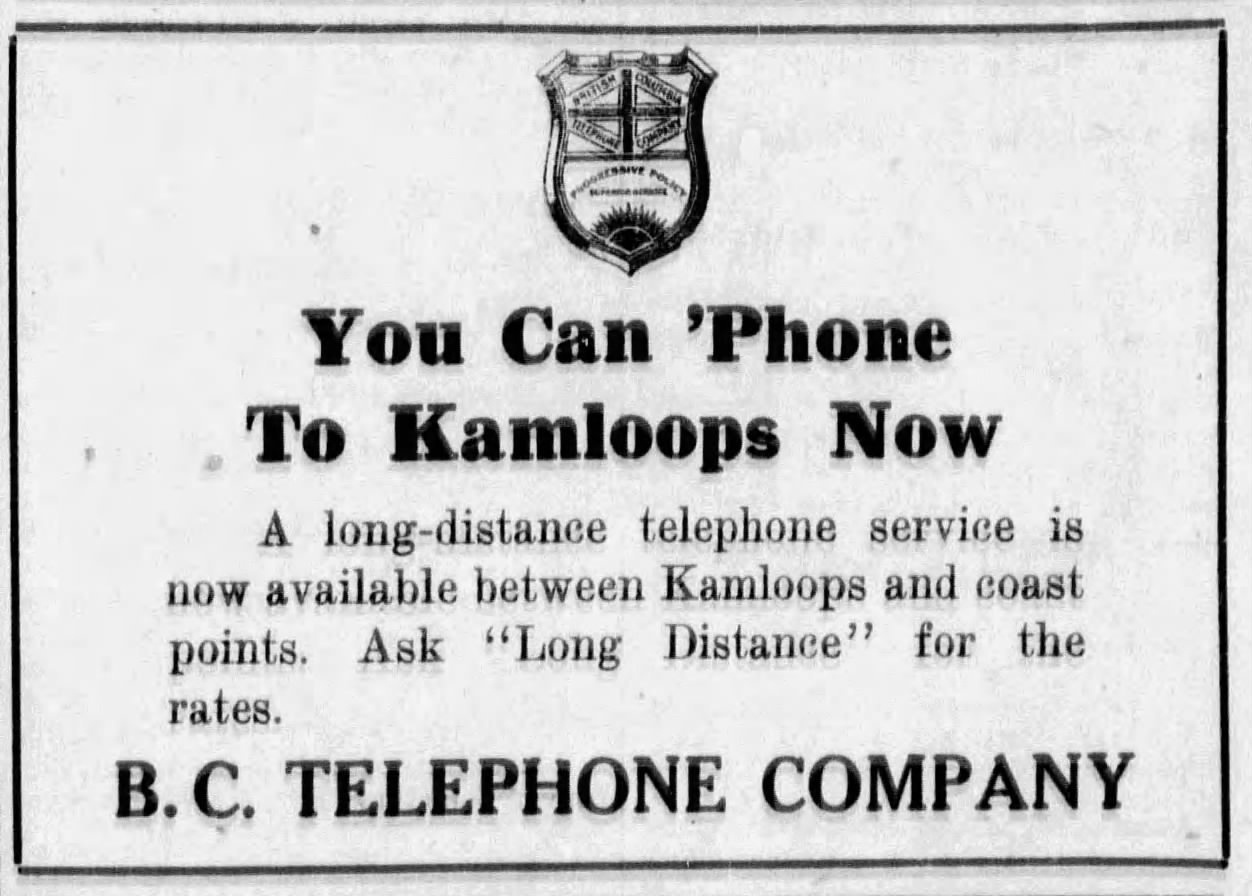“Hello?… It’s for you”. These days, finding out you have a long-distance phone call is rarely something to bat an eyelash at, but if you had loved ones living elsewhere in the 1910s and 1920s, this may have been one of the most exciting phrases of your week!
We are undoubtedly in a time of many technological advances that can leave us almost breathless with their rapid pace. The phone is a piece of technology that epitomises this. It feels to me like it hasn’t really been that long since I used my first cell phone as just a phone to make calls to people, and now my cell phone is a supercomputer that miraculously fits in the palm of my hand, ready to solve any problem I give it!
This of course, isn’t the first time people have been through a time of rapid technological advances that quickly changed the way they lived their day to day lives. The mid 1920s in BC was also a good example of this. We had a telephone company that was vastly changing the way people communicated over long distance.
The British Columbia Telephone Company (I’ll refer to the company as BC Tel from now on for brevity) was active all over the province by the early 1900s and had a couple of buildings in the Lonsdale area. It opened its first telephone headquarters in North Vancouver (called the North Vancouver Exchange) around 1910 at 147 E. 11th (below right) in a relatively small, purpose-built building, but one that was built to last - with heavy massing in a Classical revival style, referred to by some as “Masonic Style” as it resembles the types of buildings that were built to house Masonic Lodges. The Victoria BC Tel building (below left) was also built in a similar style, but was was tall rather than long.
The caption below the photo of 147 E. 11th in a BC Tel ad from 1912 confirms that it was intended to be there for a very long time. It reads “Even in the smaller cities permanency is the chief feature of construction.” However, despite being well built, this building was demolished at some point in the mid-century to make way for a more modern building, and even that one has now been demolished and replaced with condos in the last few years.
Both photos from an ad from the Sun, Dec. 22nd, 1912 edition of The Daily Advertiser, courtesy of newspapers.com
The E. 11th building would have been fascinating to research, but as there is no trace of it left, we are fortunate to still have the 117 W 1st Street building to explore. It was built in 1926 as a space to house the busy offices of the ever-expanding phone company. Like the other BC Tel buildings, this one was also built to last in the Classical Revival Style as you can see from the look of the building below. It was added to the register of “Canada’s Historic Places” in 2005 for its preservation of heritage features as well as its role as an early commercial property during Lower Lonsdale’s explosive commercial growth in the early part of the last century. It is also in the City of North Vancouver’s heritage register.
This building has seen an amazing variety of uses since it was a BC Tel office, including tobacco company, florist/gift shop, law office, New Age shop, and most recently, an organic cafe before it became the current sushi restaurant.
I really enjoyed “researching” for this post as I got to spend some time in this lovely building and got to try some of the delicious sushi being served there!
Before we enter the interior and learn about the history of BC Tel, let’s have a look at the building from the outside.
EXTERIOR DETAILS
117th W. 1st st. with a few labels I’ve added to my photo to point out some character-defining features as mentioned in the City of North Vancouver’s Heritage Planning Files.
The flat roofline is actually between where the long, white cement block line is on the left side and the top of the wall. An unusual feature to note is the long black facing of corrugated metal in the middle of the front parapet.
The photos above show how flat the roof is and how high the paparets are. The building looks much more imposing from the front and sides with the parapets to fool you.
Left to right above: Multi-pane transom windows above the entrance with cut out wood decorations flanking the centre, close-up of wood detailing, copper window trim.
Left to right below: Beautiful oak entrance door with angled vestibule entrance, entrance tiling, finely corrugated metal fascia (which a NSH colleague suggest could be covering the original B.C. Telephone Company name) with diamond-shaped detail above and stone block dentils along roofline.
INTERIOR DETAILS
The interior seems to have retained much of its original character, just as the exterior has. Standing from the back of the main room, if you imagine the kitchen set up and dining furniture is gone, you can get a sense for the size of the room and what it might have looked like in the 1920s. I’ve tried to remove some people in the centre of the photo to make it less distracting, so if it looks like I’ve captured some ghosts, that’s just my lack of photoshopping skill. ;-)
DETAILS UP CLOSE
Left to right: mosaic floor seemingly entirely intact, close-up of flower pattern, exposed brick showing where something had been attached to the wall. If you look closely you can see little pieces of wood left in the holes that would have helped attach an object once, but had broken off and left in the wall once the object was removed.
Above left: original office doors at the back, gorgeous original wood flooring and an original, long radiator with wood covering it to make an eating surface at the left. Middle: Original entrance door as seen from the inside. Right: the original fuse box/electrical panel with a BC Tel switchboard photo above it.
Above: Original light on left, homage to the building’s original use on right.
The heritage interior with the antique style lights has a beautiful ambience. The wall of windows lets in a lot of natural light and frames the greenery of the tree.
BC TELEPHONE COMPANY BRIEF HISTORY
BC Tel started out in 1891 as the “Vernon and Nelson Telephone Company", but after purchasing two smaller phone companies and receiving authorisation from the federal government to expand into the rest of BC, the company changed its name to reflect the expansion to “British Columbia Telephone Company LTD”. The Federal government then granted a charter to BC Tel in 1916 for the future rights to not only operate anywhere in BC, but run its phone lines outside the province as well.
By around 1910, BC Tel had built the North Vancouver office on E. 11th. There was a rival telephone company at the time in North Vancouver which was trying to get permission to install a second phone system in the Lower Mainland, but BC Tel had the upper hand, as it already was running the main telephone system in Vancouver and the North Shore, as well as had carte blanche to run lines everywhere in BC, so it remained the main phone company. It also had a constant presence in the newspaper, running multiple ads a month, and always trying new angles to get new phone subscribers. Sound familiar?
BC TEL IN NORTH VANCOUVER IN THE 1920s
By the mid-1920s, business was booming to the point that BC Tel had to build the building on W. 1st in order to create more office space to run the North Shore Branch. The popularity of the telephone had increased quickly as BC Tel’s fairly new “Long Distance” service was rapidly expanding and had become the main focus of their advertising. Many people by the 1920s now had a telephone, so the company’s focus turned to having people pay for long-distance calls. BC Tel was adding lines to places all over BC so quickly that they had frequent ads with new places people could call to. This must have been exciting for people at the time, who could now speak for the first time to someone in Northern or Eastern BC from their North Vancouver telephone.
Technology and invention during 1926 had hit a fever pitch, as BC Tel was also using phone lines to transmit photos as well as radio frequencies, and to top it off, October of 1926 saw the first “Talking Picture” The Jazz Singer debut as well. Even the first commercial airlines formed in the mid-1920s. The world from the North Vancouver vantage point must have felt like it was getting smaller like never before, with the ability to contact people far away and even fly to see people far away!
Here are a few ads that show the kinds of advertising BC Tel did locally from 1912-1928. The “dove of peace” ad reminds me of the confusion that can happen when texting as opposed to calling someone about a sensitive subject!
Note how long distance in the 1913 ad only advertised to places around the lower mainland but in 1926 that had stretched to Kamloops, among other places equally distant.
Taken from the Thurs, April 12, 1928 edition of The Surrey Gazette. Courtesy of newspapers.com
Taken from the Thurs, Dec.19th, 1912 edition of The Daily Advertiser. Courtesy of newspapers.com
Above, clockwise from top right: Tues, April 06, 1926- North Shore Times, Tues, Dec. 7, 1926- North Shore Times, Tues, Apr. 15th, 1913- North Shore Press, Fri, March 06, 1925- North Shore Press,
All courtesy of newspapers.com
This full page ad above ran alongside photos of BC Tel buildings, two of which were the North Vancouver offices I included at the top of the blog post.
Sunday, Dec. 22. 1912, Daily News Advertiser. Courtesy of newspapers.com
The next 80 or so years would see one merger and acquisition after another until the final one in 1999 when BC Tel merged with Telus and the company operated under the Telus name as it still does today.
I wonder what built legacy we’ll have in another hundred years in regards to today’s technology buildings? There will certainly be no trace of the mall kiosks, and some of the current Telus buildings I came across don’t look to have been built for near the long-term use as the old ones. It makes me wonder about the built heritage legacy in general of most new commercial buildings these days. What trace will we have of our built past when buildings only last a few decades and the demolition cycle is so short?
And to conclude, I have a few questions for you readers:
Have any of you been to 117 W. 1st st during any of its many iterations?
How long do you think a building should be built to last?
What memories do you have of changing phone technology over the years that really stand out for you?
* All photos unless noted are taken by Jenny Morgan
Except where indicated, text and images Copyright @ North Shore Heritage and Jenny Morgan 2017-2023. All rights reserved. Republication in whole or in part is prohibited without the written consent of the copyright holder.
Sources:
